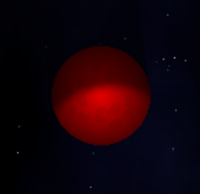mNo edit summary |
(→Trivia) Tag: Visual edit |
||
| (6 intermediate revisions by 3 users not shown) | |||
| Line 7: | Line 7: | ||
|atmosphere = No |
|atmosphere = No |
||
|solid = Yes |
|solid = Yes |
||
| − | |analogue = [[wikipedia:Mars|Mars]]}}The |
+ | |analogue = [[wikipedia:Mars|Mars]]}}The red planet, shown as '''RED''' on the [[NaviComp]], is a comparatively large planet with no atmosphere, explored in [[Mission 15]], [[Mission 21]] and [[Mission 35]]. |
| + | |||
| + | This planet is likely the [[Space Agency]] analogue of [[wikipedia:Mars|Mars]]. It has a low gravitational pull. Due to this, it is difficult to land. A failed attempt will result in the lander bouncing off of the surface, or [[Explosions|exploding]] on impact. |
||
From RED (+13) you can reach [[YEL]] (875), [[GRN]] (730), and [[LUN]] (990). |
From RED (+13) you can reach [[YEL]] (875), [[GRN]] (730), and [[LUN]] (990). |
||
| ⚫ | |||
| − | *The radius of the planet has been calculated to be about 2.46 [[NaviComp]] units. |
||
| ⚫ | |||
| ⚫ | |||
| ⚫ | |||
| ⚫ | |||
| − | [[File:Image.jpg|thumb|190px|left|A [[Lunar Module Descent]] with [[Lunar Module Ascent]] landed on RED.]] |
||
| ⚫ | |||
| ⚫ | |||
| ⚫ | |||
| + | *A geometric positioning experiment conducted by [[User:2020dragons|2020dragons]] revealed that RED's radius is 4 NaviComp units, and not 2.46 as intially reported. |
||
| + | {{Waypoints}} |
||
[[Category:Planets]] |
[[Category:Planets]] |
||
[[Category:Waypoints]] |
[[Category:Waypoints]] |
||
Revision as of 23:38, 31 July 2020
Overview

| |
|
| |
| NaviComp name | RED |
| NaviComp coordinates |
X: -500 |
| Has atmosphere | No |
| Has solid surface | Yes |
| Can be landed on | Yes |
| Can be splashed-down on | No |
The red planet, shown as RED on the NaviComp, is a comparatively large planet with no atmosphere, explored in Mission 15, Mission 21 and Mission 35.
This planet is likely the Space Agency analogue of Mars. It has a low gravitational pull. Due to this, it is difficult to land. A failed attempt will result in the lander bouncing off of the surface, or exploding on impact.
From RED (+13) you can reach YEL (875), GRN (730), and LUN (990).
Trivia
- Using LUN is a great check point especially if you send a few refuel tanks into orbit.
- Unlike the real-world planet Mars, which RED is based off, RED has no atmosphere.
- While RED has low gravity (just under 1 NCU/s) it has a large Circle of Influence.
- A geometric positioning experiment conducted by 2020dragons revealed that RED's radius is 4 NaviComp units, and not 2.46 as intially reported.
| Waypoints | |
|---|---|
| SOL | |
| Planets | BLU • PUR • KAT • GOL • HOM • EMA • JOR • LUN • GRN • RED • YEL • ENC |
| Stations | |
| STA • MSS • ADS | |
